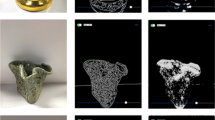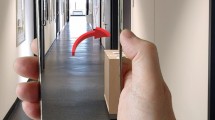Abstract
The ability to visualize occluded objects or people offers tremendous potential to users of augmented reality (AR). This is especially true in mobile applications for urban environments, in which navigation and other operations are hindered by the urban infrastructure. This “X-ray vision” feature has intrigued and challenged AR system designers for many years, with only modest progress in demonstrating a useful and usable capability. The most obvious challenge is to the human visual system, which is being asked to interpret a very unnatural perceptual metaphor. We review the perceptual background to understand how the visual system infers depth and how these assumptions are or are not met by augmented reality displays. In response to these challenges, several visualization metaphors have been proposed; we survey these in light of the perceptual background. Because augmented reality systems are user-centered, it is important to evaluate how well these visualization metaphors enable users to perform tasks that benefit from X-ray vision. We summarize studies reported in the literature. Drawing upon these analyses, we offer suggestions for future research on this tantalizing capability.
Access this chapter
Tax calculation will be finalised at checkout
Purchases are for personal use only
Similar content being viewed by others
Notes
- 1.
1 Personal space, action space, and vista space are commonly termed as near-field, medium-field, and far-field distances, respectively. In this chapter, we will use the latter set of terms.
References
Avery, B., Sandor, C., Thomas, B.H.: Improving spatial perception for augmented reality X-ray vision. In: IEEE Virtual Reality, pp. 79–82 (2009)
Bajura, M., Fuchs, H., Ohbuchi, R.: Merging virtual objects with the real world: Seeing ultrasound imagery within the patient. Computer Graphics (Proceedings of SIGGRAPH’92) 26(2), 203–210 (1992)
Bane, R., Höllerer, T.: Interactive tools for virtual X-ray vision in mobile augmented reality. In: IEEE International Symposium on Mixed and Augmented Reality, pp. 231–239 (2004)
Biocca, F.A., Rolland, J.P.: Virtual eyes can rearrange your body: Adaptation to visual displacement in see-through, head-mounted displays. Presence: Teleoperators and Virtual Environments 7(3), 262–277 (1998)
Bruce, V., Green, P.R., Georgeson, M.A.: Visual Perception: Physiology, Psychology, and Ecology, 3rd edn. Psychology Press (1996)
Cutting, J.E.: Reconceiving perceptual space. In: H. Hecht, R. Schwartz, M. Atherton (eds.) Looking into Pictures: An Interdisciplinary Approach to Pictorial Space, chap. 11, pp. 215–238. MIT Press (2003)
Cutting, J.E., Vishton, P.M.: Perceiving layout and knowing distances: The integration, relative potency, and contextual use of different information about depth. In: Handbook of perception and cognition, Vol. 5: Perception of space of motion, pp. 69–117. Academic Press (1995)
Dey, A., Cunningham, A., Sandor, C.: Evaluating depth perception of photorealistic mixed reality visualizations for occluded objects in outdoor environments. In: 17th ACM Symposium on Virtual Reality Software and Technology, pp. 211–218 (2010)
Dey, A., Jarvis, G., Sandor, C., Wibowo, A.K., Mattila, V.V.: An evaluation of augmented reality X-ray vision for outdoor navigation. In: The 21st International Conference on Artificial Reality and Telexistence, pp. 28–32 (2011)
Ellis, S.R., Bucher, U.J., Menges, B.M.: The relationship of binocular convergence and errors in judged distance to virtual objects. In: Proceedings of the International Federaion of Automatic Control, pp. 297–301 (1995)
Ellis, S.R., Menges, B.M.: Localization of virtual objects in the near visual field. Human Factors 40(3), 415–431 (1998)
Feiner, S.K., Seligmann, D.D.: Cutaways and ghosting: Satisfying visibility constraints in dynamic 3D illustrations. The Visual Computer 8(5–6), 292–302 (1993)
Fidopiastis, C.M.: User-centered virtual environment assessment and design for cognitive rehabilitation applications. Ph.D. thesis, Department of Modeling and Simulation, University of Central Florida (2006)
Fuchs, H., Livingston, M.A., Raskar, R., Colucci, D., Keller, K., State, A., Crawford, J.R., Rademacher, P., Drake, S.H., Meyer, A.A.: Augmented reality visualization for laparoscopic surgery. In: Proceedings of First International Conference on Medical Image Computing and Computer-Assisted Intervention, pp. 934–943 (1998)
Furness, L.T.A.: The application of head-mounted displays to airborne reconnaissance and weapon delivery. Tech. Rep. TR-69-241, U.S. Air Force Avionics Laboratory, Wright-Patterson AFB (1969)
Furness, T.A.: The super cockpit and its human factors challenges. In: Proceedings of the Human Factors Society 30th Annual Meeting, pp. 48–52. Human Factors and Ergonomics Society (1986)
Jerome, C.J., Witmer, B.G.: The perception and estimation of egocentric distance in real and augmented reality environments. In: Proceedings of the Human Factors and Ergonomics Society Annual Meeting, vol. 49, pp. 2249–2252 (2005)
Jones, J.A., Swan II, J.E., Singh, G., Ellis, S.R.: Peripheral visual information and its effect on distance judgments in virtual and augmented environments. In: ACM SIGGRAPH Symposium on Applied Perception in Graphics and Visualization, pp. 29–35 (2011)
Jones, J.A., Swan II, J.E., Singh, G., Kolstad, E., Ellis, S.R.: The effects of virtual reality, augmented reality, and motion parallax on egocentric depth perception. In: ACM SIGGRAPH Symposium on Applied Perception in Graphics and Visualization, pp. 9–14 (2008)
Julier, S., Lanzagorta, M., Baillot, Y., Rosenblum, L., Feiner, S., Hollerer, T., Sestito, S.: Information filtering for mobile augmented reality. In: Proceedings of IEEE and ACM International Symposium on Augmented Reality, pp. 3–11 (2000)
Kalkofen, D., Mendez, E., Schmalstieg, D.: Interactive focus and context visualization for augmented reality. In: IEEE International Symposium on Mixed and Augmented Reality, pp. 191–201 (2007)
Kirkley, Jr., S.E.H.: Augmented reality performance assessment battery (ARPAB: Object recognition, distance estimation, and size estimation using optical see-through head-worn displays. Ph.D. thesis, Instructional Systems Technology, Indiana University (2003)
Kiyokawa, K., Kurata, Y., Ohno, H.: An optical see-through display for mutual occlusion of real and virtual environments. Computers and Graphics 25(5), 765–779 (2001)
Klein, G., Murray, D.: Simulating low-cost cameras for augmented reality compositing. IEEE Transactions on Visualization and Computer Graphics 16(3), 369–380 (2010)
Liu, S., Hua, H., Cheng, D.: A novel prototype for an optical see-through head-mounted display with addressable focus cues. IEEE Transactions on Visualization and Computer Graphics 16(3), 381–393 (2010)
Livingston, M.A., Ai, Z., Swan II, J.E., Smallman, H.S.: Indoor vs. outdoor depth perception for mobile augmented reality. In: IEEE Virtual Reality, pp. 55–62 (2009)
Livingston, M.A., Brown, D., Julier, S.J., Schmidt, G.S.: Military applications of augmented reality. In: NATO Human Factors and Medicine Panel Workshop on Virtual Media for Military Applications (2006)
Livingston, M.A., Karsch, K., Ai, Z., Gibson, LT G.O.: User interface design for military ar applications. Virtual Reality 15(2–3), 175–184 (2011)
Livingston, M.A., Swan II, J.E., Gabbard, J.L., Höllerer, T.H., Hix, D., Julier, S.J., Baillot, Y., Brown, D.: Resolving multiple occluded layers in augmented reality. In: IEEE International Symposium on Mixed and Augmented Reality, pp. 56–65 (2003)
Livingston, M.A., Zanbaka, C., Swan II, J.E., Smallman, H.S.: Objective measures for the effectiveness of augmented reality. In: IEEE Virtual Reality, pp. 287–288 (2005)
Loomis, J.M., Knapp, J.M.: Visual perception of egocentric distance in real and virtual environments. In: L.J. Hettinger, M.W. Haas (eds.) Virtual and Adaptive Environments, pp. 21–46. Lawrence Erlbaum Associates (2003)
McCandless, J.W., Ellis, S.R.: The effect of eye position on the projected stimulus distance in a binocular head-mounted display. In: Stereoscopic Displays and Virtual Reality Systems VII, Proceedings of SPIE Vol. 3957, pp. 41–48 (2000)
McCandless, J.W., Ellis, S.R., Adelstein, B.D.: Localization of a time-delayed, monocular virtual object superimposed on a real environment. Presence: Teleoperators and Virtual Environments 9(1), 15–24 (2000)
Nagata, S.: How to reinforce perception of depth in single two-dimensional pictures. In: Pictorial Communication in Virtual and Real Environments, chap. 35, pp. 527–545. Taylor & Francis, Inc. (1991)
Plumert, J.M., Kearney, J.K., Cremer, J.F., Recker, K.: Distance perception in real and virtual environments. ACM Transactions on Applied Perception 2(3), 216–233 (2005)
Rolland, J.P., Ariely, D., Gibson, W.: Towards quantifying depth and size perception in virtual environments. Presence: Teleoperators and Virtual Environments 4(1), 24–49 (1995)
Rolland, J.P., Fuchs, H.: Optical versus video see-through head-mounted displays. Presence: Teleoperators and Virtual Environments 9(3), 287–309 (2000)
Rolland, J.P., Meyer, C., Arthur, K., Rinalducci, E.J.: Method of adjustments versus method of constant stimuli in the quantification of accuracy and precision of rendered depth in head-mounted displays. Presence: Teleoperators and Virtual Environments 11(6), 610–625 (2002)
Sandor, C., Cunningham, A., Dey, A., Mattila, V.V.: An augmented reality X-ray system based on visual saliency. In: IEEE International Symposium on Mixed and Augmented Reality, pp. 27–36 (2010)
Sandor, C., Cunningham, A., Eck, U., Urquhart, D., Jarvis, G., Dey, A., Barbier, S., Marner, M., Rhee, S.: Egocentric space-distorting visualizations for rapid environment exploration in mobile mixed reality. In: IEEE Virtual Reality (2010)
Schall, G., Mendez, E., Kruijff, E., Veas, E., Junghanns, S., Reitinger, B., Schmalstieg, D.: Handheld augmented reality for underground infrastructure visualization. Personal and Ubiquitous Computing 13(4), 281–291 (2009)
Schiffman, H.R.: Sensation and Perception, 5th edn. John Wiley & Sons (2001)
Singh, G., Swan II, J.E., Jones, J.A., Ellis, S.R.: Depth judgment measures and occluding surfaces in near-field augmented reality. In: ACM SIGGRAPH Symposium on Applied Perception in Graphics and Visualization, pp. 149–156 (2010)
State, A., Hirota, G., Garrett, W.F., Chen, D.T., Livingston, M.A.: Superior augmented reality registration by integrating landmark tracking and magnetic tracking. In: Computer Graphics Proceedings, Annual Conference Series (Proceedings of SIGGRAPH’96), pp. 429–438 (1996)
Stix, G.: See-through view: Virtual reality may guide physician’s hands. Scientific American 267(3), 166 (1992)
Sugano, N., Kato, H., Tachibana, K.: The effects of shadow representation of virtual objects in augmented reality. In: IEEE International Symposium on Mixed and Augmented Reality, pp. 76–83 (2003)
Swan II, J.E., Jones, A., Kolstad, E., Livingston, M.A., Smallman, H.S.: Egocentric depth judgments in optical, see-through augmented reality. IEEE Transactions on Visualization and Computer Graphics 13(3), 429–442 (2007)
Swan II, J.E., Livingston, M.A., Smallman, H.S., Brown, D., Baillot, Y., Gabbard, J.L., Hix, D.: A perceptual matching technique for depth judgments in optical, see-through augmented reality. In: IEEE Virtual Reality, pp. 19–26 (2006)
Tsuda, T., Yamamoto, H., Kameda, Y., Ohta, Y.: Visualization methods for outdoor see-through vision. IEICE Transactions on Information and Systems E89–D(6), 1781–1789 (2006)
Witt, J.K., Proffitt, D.R., Epstein, W.: Perceiving distance: A role of effort and intent. Perception 33(5), 577–590 (2004)
Zollmann, S., Kalkofen, D., Mendez, E., Reitmayr, G.: Image-based ghostings for single layer occlusions in augmented reality. In: IEEE International Symposium on Mixed and Augmented Reality, pp. 19–26 (2010)
Acknowledgements
The authors would like to thank Steve Ellis, Cali Fidopiastis, Henry Fuchs, LT Gregory O. Gibson, Tobias Höllerer, Christian Jerome, Sonny Kirkley, Jannick Rolland, Andrei State, and Ed Swan for their assistance in the preparation of this chapter.
Author information
Authors and Affiliations
Corresponding author
Editor information
Editors and Affiliations
Rights and permissions
Copyright information
© 2013 Springer Science+Business Media New York
About this chapter
Cite this chapter
Livingston, M.A., Dey, A., Sandor, C., Thomas, B.H. (2013). Pursuit of “X-Ray Vision” for Augmented Reality. In: Huang, W., Alem, L., Livingston, M. (eds) Human Factors in Augmented Reality Environments. Springer, New York, NY. https://doi.org/10.1007/978-1-4614-4205-9_4
Download citation
DOI: https://doi.org/10.1007/978-1-4614-4205-9_4
Published:
Publisher Name: Springer, New York, NY
Print ISBN: 978-1-4614-4204-2
Online ISBN: 978-1-4614-4205-9
eBook Packages: Computer ScienceComputer Science (R0)




